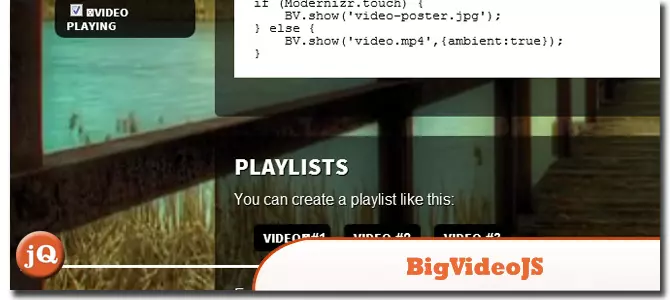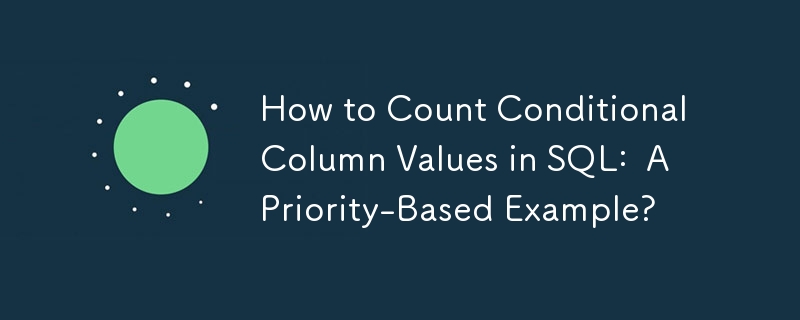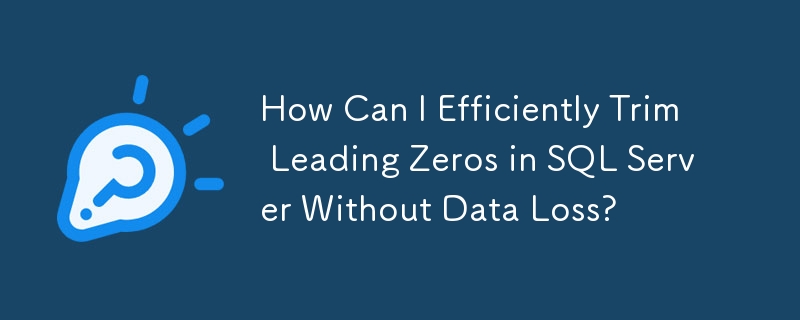Found a total of 10000 related content

Customizing media player controls for HTML5 video/audio.
Article Introduction:To customize HTML5 audio and video controls, you must first hide the default controls, then implement basic functions, and finally optimize the user experience. 1. Remove the controls attribute in or tags to hide native controls; 2. Use HTML and CSS to build a custom control bar, including play/pause buttons, progress bars and volume control; 3. Bind events through JavaScript, such as play(), pause(), timeupdate and volume adjustment; 4. Add load status prompts (listening to waiting events) and error handling (listening to error events) to improve user interaction experience. These steps are clear logic and well-structured, and can be flexibly adapted to the UI style.
2025-07-05
comment 0
1022

5 jQuery Background Video Plugins
Article Introduction:Five excellent jQuery background video plug-ins are recommended to easily create a cool website!
Many websites use pictures as backgrounds, and the effect is very cool. Since you can use pictures, why not use videos? This article will recommend five powerful jQuery background video plug-ins to help you easily videotape your website or blog background! Ready? Let's get started! Related readings:
Top 10 jQuery and HTML5 media players
jQuery parallax tutorial—animation title background
BIGVIDEO.JS
This plugin makes it a breeze to add adaptively populated background videos. It can play muted atmosphere background video (or a series of videos) or it can also be used as a player to display video playback
2025-02-25
comment 0
769

HTML5 Video and Audio: The Markup - SitePoint
Article Introduction:Detailed explanation of HTML5 video and audio tags: Building a responsive video player
This article is excerpted from the book "HTML5 & CSS3 for the Real World, 2nd Edition" co-authored by Alexis Goldstein, Louis Lazaris and Estelle Weyl. This book is available in major bookstores around the world, and you can also purchase the e-book version here.
Core points
HTML5's video and audio tags allow for embedded video and audio elements directly in HTML code, without the need for external plug-ins or players.
HTML5 video and audio tags contain multiple attributes to control the behavior of these elements, such as autoplay
2025-02-18
comment 0
340

How to get the current playback time and duration of a video?
Article Introduction:If you want to know the current playback time and total duration of the video, the method varies by platform. 1. In a web browser, you can directly view the video control bar to get the current time and total time; developers can use JavaScript code to read HTML5 element information. 2. In the mobile app, click the screen display control bar to roughly determine the current playback position and total duration, but the precise data requires professional tools to analyze. 3. Local players such as VLC, MPV, etc. will directly display the current time and total time on the interface, and you can also view detailed metadata through media information. There are ready-made solutions in different environments, and the details are easily overlooked but the operation is not complicated.
2025-06-21
comment 0
336

How to create custom controls for HTML5 video player?
Article Introduction:HTML5 video player can be customized. The specific methods are: 1. Hide the native controls and remove the controls attributes of the tags; 2. Use HTML to create custom controls such as play/pause buttons, progress bars, volume control, full-screen buttons and time display; 3. Take over the video control logic through JavaScript to realize functions such as playback, pause, jump, volume adjustment, etc.; 4. Use CSS to beautify the appearance of the control and overwrite the default style; 5. Pay attention to compatibility issues, such as full-screen support on the mobile terminal, obtaining the duration after loading metadata, and providing load failure prompts.
2025-07-14
comment 0
948

How to Add Audio and Video to Your Webpage: A Step-by-Step Tutorial
Article Introduction:You can add audio and video to web pages by using HTML5 and tags. Specific steps include: 1. Embed media files using and tags; 2. Customize control and styles through JavaScript and CSS; 3. Use poster attributes to display preview images before video playback; 4. Provide multiple formats of Fallback content to ensure cross-browser compatibility; 5. Add subtitles or scripts to improve Accessibility; 6. Use preload attributes to optimize performance; 7. Avoid automatic playback to improve user experience; 8. Use MediaSourceExtensions API to implement complex streaming solutions; 9. Consider user bandwidth and device capabilities for responsive settings.
2025-06-19
comment 0
411

How do I use the poster attribute to display a preview image before the video starts playing?
Article Introduction:Poster attributes are used in HTML5 to specify the preview image displayed before the video starts playing, which is implemented by adding an image URL to the tag. When using it, you need to ensure the correct path. The picture should be a high-quality keyframe screenshot to avoid blurred or overly dark images, and optimize the loading speed; some browsers or mobile devices may not display posters due to fast video loading, dynamic src or automatic playback restrictions; posters can be scaled through CSS, but the style is restricted directly. Reasonable selection and processing of posters can improve the user experience.
2025-06-22
comment 0
864

Building a Custom HTML5 Video Player Interface
Article Introduction:To create a custom HTML5 video player, you need to set up an HTML structure, implement control interaction and design a CSS style. 1. Set the infrastructure: Use tags and custom control areas, add necessary attributes to ensure compatibility; 2. Implement control interaction: control playback/pause through JavaScript listening button click events, and monitor the timeupdate event update progress bar and time display; 3. Design custom styles: use CSS to hide native controls and beautify the player's appearance, including style adjustments of buttons, progress bars and other elements.
2025-07-14
comment 0
489

Can a single HTML5 page have multiple tags?
Article Introduction:Yes, an HTML5 page can have multiple tags. 1. Multiple tags can be used to display video collections, teaching clips, social media videos or compare content shot from different angles; 2. When using it, you need to pay attention to the browser's restrictions on automatic playback. It is recommended to set muted attributes or control playback through JavaScript; 3. You need to pay attention to performance issues to avoid page lag, which can be solved by delaying loading and optimizing video encoding; 4. It is recommended to unify the control style and design reasonable interactive logic, such as pausing other videos to improve the user experience.
2025-06-28
comment 0
472

Using the HTML `` and `` elements for media.
Article Introduction:The sum elements in HTML5 can be embedded in media files through the src attribute and use controls to display controls; support multi-format fallback, such as tags specify different formats; autoplay, loop, muted and other attributes can be set to control playback behavior; browsers may restrict automatic playback, and it is recommended to use them with muted; custom UI and interaction can be achieved by hiding the default controls and combining JavaScript, such as manually adding play buttons and listening to video end events.
2025-07-02
comment 0
813

What can be done for H5 page production
Article Introduction:H5 page production is not only suitable for creating simple web pages, but also has powerful functions, including: Dynamic interaction: Use elements such as animation, video and 3D models to provide users with an immersive experience. Mobile-friendly: Responsive design ensures the best browsing experience on a variety of devices. Data visualization: present data in an intuitive way, using elements such as charts and maps. Games and interactive applications: Develop lightweight games and interactive applications to enhance user engagement. Cross-platform compatibility: Based on a combination of HTML5, CSS3 and JavaScript, but compatibility remains a challenge. Performance optimization: For complex pages, code efficiency needs to be optimized. Security: Security vulnerabilities need to be prevented, such as
2025-04-06
comment 0
566

How to make a responsive website with HTML5 and CSS3?
Article Introduction:The key to making a responsive website lies in the reasonable cooperation between HTML5 and CSS3, and the core is to make web pages display well on different devices. 1. Use HTML5 semantic tags to build clear structures, such as, , etc., to make the code easier to read and facilitate search engine crawling; 2. Use CSS3 media query to achieve multi-device adaptation, and apply different rules by detecting screen width, such as setting breakpoints such as mobile phones and tablets; 3. Use elastic layout (Flexbox or Grid) to deal with alignment and arrangement issues, and ensure that the navigation bar and other content automatically adapt to the screen; 4. Set image adaptation, use max-width:100% and srcset attributes to ensure that the image does not destroy the layout and improve the loading effect. Mastering these four key points can achieve compatibility with multiple settings
2025-07-13
comment 0
478

How to optimize critical CSS loading
Article Introduction:Critical CSS optimization improves first loading speed by prioritizing the minimum CSS required to load the first screen. CSS is the style code that is necessary for the page to render for the first time, to avoid the browser from white screen or delayed display due to loading all CSS. The extraction methods include automatic extraction using tools such as Penthouse, manual copying of the first screen style, or automatic generation in combination with the construction process. The injection method is to inline the key CSS to the style tag in the head. The rest of the CSS is loaded through the link tag in conjunction with preload or JavaScript. The media attribute can also be used to control the loading timing. Things to note include increased maintenance costs, dynamic content affects judgment, avoiding excessive splitting, and combining other optimization strategies. Use Next.js, etc.
2025-06-30
comment 0
771


Dave The Diver: How To Catch Spider Crabs
Article Introduction:In Dave The Diver, there are some creatures that are not easy to catch. Or, catch alive that is. The spider crab is one of those very species, making it seem like the only way to bring these crustaceans back up to land is to viciously crack them up w
2025-01-10
comment 0
786

Prepare for Interview Like a Pro with Interview Questions CLI
Article Introduction:Prepare for Interview Like a Pro with Interview Questions CLI
What is the Interview Questions CLI?
The Interview Questions CLI is a command-line tool designed for JavaScript learners and developers who want to enhance their interview
2025-01-10
comment 0
1418



















